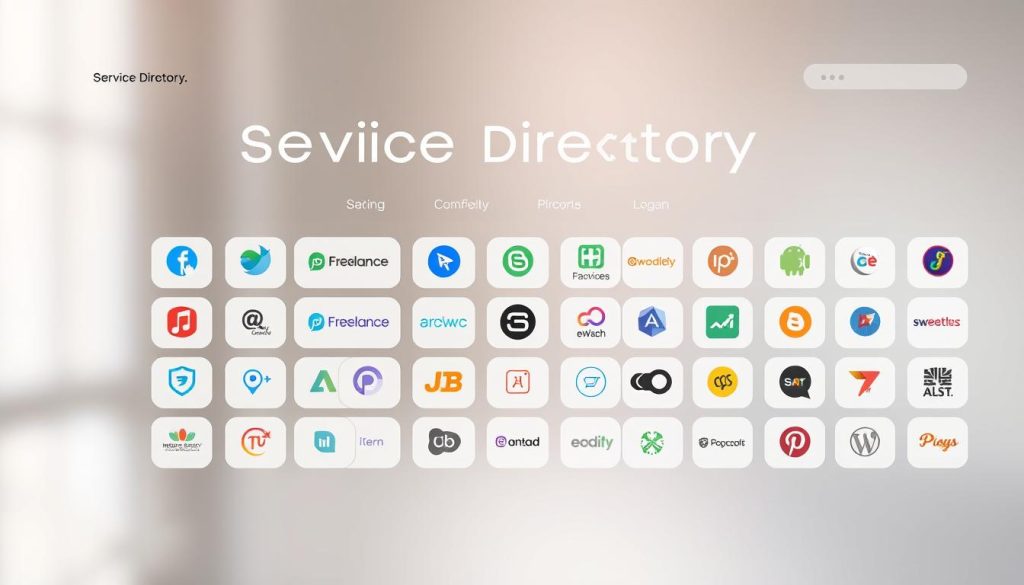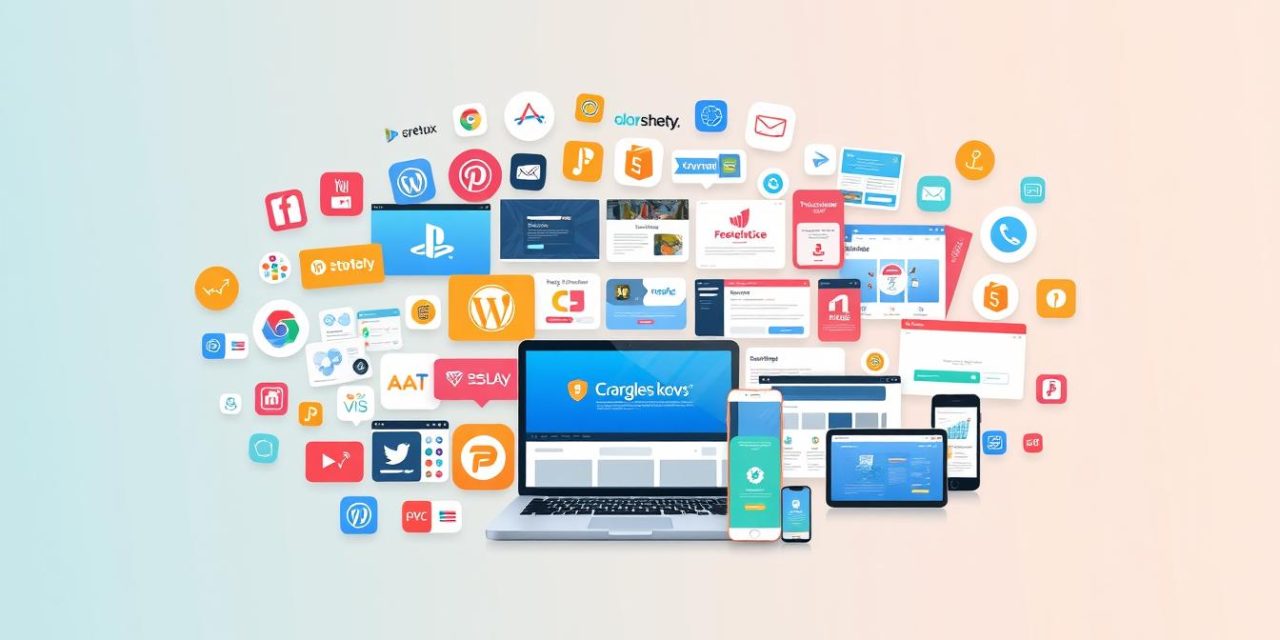Ready to get visible and win better clients? This quick guide lists the top places that help a freelancer grow a credible presence and find paid work fast.
Discover trusted directories like the NYC Tech Directory and the Black Freelancers Web Directory that connect you with hiring teams. Use the Freelance Rate Database to set fair fees and compare market rates so you bid with confidence.
Learn new skills quickly with platforms such as Udemy, LinkedIn Learning, Coursera, YouTube, and HubSpot Academy. These sites offer certificates, ratings, and community feedback to help you pick quality courses without wasting time.
Practical playbooks from Elna Cain, Pat Flynn (Smart Passive Income), and Alex Cattoni (Copy Posse) give step-by-step tactics to land your next client and improve your copy and pitch.
Table of Contents
Key Takeaways
- Use niche directories to boost visibility with hiring teams.
- Compare rates with industry databases before quoting clients.
- Pick courses with strong ratings and clear certificate value.
- Follow creators who share actionable weekly tactics.
- Bundle learning and visibility into a portfolio that sells.
Service Directory: High-Impact Platforms to Find Work, Build Credibility, and Set Fair Rates
Targeted service boards make it easier for clients to find your portfolio and hire with confidence. Start by listing where hiring teams search and by showing clear outcomes in a few polished examples.

Tech Talent Visibility: NYC Tech Directory
Put your skills in front of 800+ companies. The NYC Tech Directory is a practical tool to grow visibility, network, and add recent projects to a portfolio that employers respect.
Opportunity Equity: Black Freelancers Web Directory
The Black Freelancers Web Directory boosts visibility and client access for Black professionals. It uses community reach to counter historic gaps and includes clear steps on how to join.
Price with Confidence: Freelance Rate Transparency Database
The Freelance Rate Database lets a freelancer compare and add rates. This shared database reduces guesswork, helps both client and freelancer, and aims to make a difference in pricing fairness.
Quick tips to get started
- Profile essentials: clean headshot, short services summary, and niche keywords.
- Link 2–4 portfolio items with context on role and measurable results.
- Share direct contact and state basic contract expectations to speed hiring.
- Track views and inquiries; tweak your headline and first three bullets to lift conversions.
- Reference the rate database in negotiations to anchor fair pricing and avoid scope creep.
Learn, Certify, and Level Up: The best freelance online resources for skills and credentials
Level up fast with a compact set of learning platforms that match client needs and portfolio gaps.
Udemy is the go-to for course-by-course upskilling. Prices drop often to €10–€20. Check ratings and previews before you buy. Add certificates to your website to show proof of completion.
Skillshare
Skillshare offers ~30,000 short classes under one membership. It’s ideal for creative activities and fast experiments. No certificates, but it’s cheap for sampling many topics.
LinkedIn Learning
LinkedIn Learning focuses on business skills and gives certificates that appear on your profile. Use it to boost visibility and attract steady work.
Coursera
Coursera provides university-led courses and full specializations. Audit many classes for free, and pay only when the credential matters for a client pitch or career move.
YouTube & HubSpot Academy
YouTube hosts endless tutorials and talks from experts like The Futur and Marie Forleo. It’s great for quick fixes between projects.
HubSpot Academy offers free marketing certifications. Use them in proposals when clients ask for verified knowledge.
- Smart approach: one main course, one short tutorial, one practice project.
- Track hours per week and tie learning to immediate client needs.
- Check platform boards and communities to speed getting started and compare pathways.
From first client to steady work: practical pathways, tools, and tips
A practical path to steady work focuses on three things: clear offers, a compact tool stack, and regular outreach. Follow small, repeatable steps each week and you’ll see progress in months, not years.

Elna Cain: a clear quick guide to pitches, samples, invoicing, and getting started fast
Start small and be specific. Write three targeted pitches, make two samples that match your ideal client’s needs, and publish them on a simple website. Add a short “how we work” section that covers timelines, revisions, and contract basics so clients feel confident.
Copy Posse: copywriting skills across the funnel to grow offers and close clients
Use Copy Posse frameworks to shape offers for landing pages, email sequences, and ads. Treat copy as a business tool: package services into clear consulting offers (audit, strategy, implementation) so a client can choose what fits their budget.
Smart Passive Income: mindset, systems, and audience-building for long-term freelancing
Listen to Smart Passive Income to build systems that reduce daily pain. Use outreach templates, an editorial calendar, and simple billing practices. Track money weekly, send invoices on milestones, and set late-fee terms in your contract.
« In your first year, aim for steady activities: 5–10 high-quality pitches per week and one case study per month. »
- Keep your tool stack light: doc editor for proposals, a billing tool, and a contract template.
- Price by outcome and reference rate transparency to make a clear difference in negotiations.
- Review progress quarterly: which guide or tool worked, where clients came from, then double down.
For more marketing tactics that help a freelancer grow, see this boost your career marketing guide.
Conclusion
Make progress simple: add your profile to a directory and complete a single lesson that fills a portfolio gap this week.
Pick one visibility tool (for example, the NYC Tech Directory or the Black Freelancers Web Directory) and one learning tool like Udemy or LinkedIn Learning. These paired steps help you get started and win more work fast.
Keep your tool stack lean. Update your portfolio, contact details, and pricing using the Freelance Rate Database so you protect margins in your first year.
Set a weekly 30-minute money review for billing, filing, and finances. If you scale into consulting, offer an entry audit plus a short strategy session to help clients feel supported and ready to sign.
Small steps, repeated, remove pain and build steady work.
FAQ
What platforms help me find clients and build credibility quickly?
Platforms like the NYC Tech Directory, Black Freelancers Web Directory, and rate-benchmark tools give visibility and trust. Create a polished profile, add portfolio links, and share clear contact details. Use directories to target specific industries and the rate database to set competitive, fair pricing.
How do I set rates with confidence?
Use the Freelance Rate Transparency Database to compare pay by role, experience, and location. Factor in taxes, software subscriptions, and time for non-billable work when calculating hourly or project fees. Review peers’ ranges and adjust for specialization or faster delivery.
Which sites offer affordable courses and certifications to boost my skills?
Udemy and Skillshare are great for low-cost, practical courses. LinkedIn Learning provides professional business training with certificates that show on your profile. Coursera offers university-level specializations you can audit for free, while HubSpot Academy supplies useful marketing certifications at no cost.
Can I learn everything for free?
Many resources are free or low-cost. YouTube hosts tutorials and expert talks for immediate learning. HubSpot Academy and some Coursera audits are free too. Paid courses speed up mastery and provide structured paths, but you can build core skills without heavy spending.
What are quick profile and portfolio tips that win clients?
Lead with a clear headline describing your service and outcome. Show 3–5 strong portfolio pieces with brief case notes and results. Include a concise bio, contact link, and client testimonials. Make it easy for prospects to assess fit and reach you.
Which creators or blogs offer practical, step-by-step guides for getting started?
Elna Cain offers clear guides on pitches, samples, and invoicing. Copy Posse focuses on persuasive copywriting across funnels. Smart Passive Income covers mindset, systems, and audience-building for longer-term work stability.
How do I handle invoicing and payment collection efficiently?
Use invoicing tools like QuickBooks, FreshBooks, or Wave to generate professional invoices and track payments. Set clear payment terms (due date, late fees) in your contract, offer multiple payment options, and follow a polite reminder schedule for overdue invoices.
Are there directories that improve my visibility to specific client types?
Yes. The NYC Tech Directory targets tech employers and startups, while the Black Freelancers Web Directory connects you with clients prioritizing diversity. Choose directories aligned with the industries or client demographics you want to reach.
What legal or contract basics should I have in place before taking clients?
Use a simple contract that covers scope, deliverables, timeline, payment terms, revisions, and termination. Include intellectual property and confidentiality clauses if needed. Templates are available through platforms like LegalZoom or Rocket Lawyer, but consider a consultation with an attorney for complex deals.
How can I grow from one-off projects to steady work?
Deliver excellent results, ask for referrals and testimonials, and create repeatable offers. Build an email list or social presence to nurture prospects. Consider retainer packages or monthly services to convert occasional clients into ongoing relationships.





